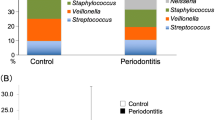Abstract
Introduction. Recent studies suggest that chronic infections, including those associated with periodontitis, increase the risk for coronary vascular disease. We hypothesize that oral microorganisms including periodontal bacterial pathogens enter the blood stream during transient bacteremias where they may play a role in the development and progression of atherosclerosis.
Materials and Methods. To test this hypothesis, 34 human specimens obtained during carotid endarterectomy or bypass procedures were examined by use of specific oligonucleotide primers for Porphyromonas gingivalis, Prevotella intermedia, Actinobacillus actinomycetemcomitans and Bacteroides forsythus in polymerase chain reaction (PCR) assays.
Results. Twenty (59%) of the 34 specimens tested positive for bacterial 16S rDNA. Subsequent hybridization of the bacterial 16S rDNA positive specimens with species-specific oligonucleotide probes revealed that 32,4% of the 34 atheromas tested positive for at least one of the target periodontal pathogens. Further analysis of the results in the bacterial positive group (n=20) shows that 55% of the atheromas tested positive for at least one of the target periodontal pathogens.
Conclusion. These findings indicate that periodontal pathogens are present in atherosclerotic plaques, where they may play a role in the development and progression of atherosclerosis leading to coronary vascular disease and other clinical sequelae.
Zusammenfassung
Einleitung. In aktuellen Studien wird behauptet, dass chronische Infektionen, darunter auch Parodontitis, das Risiko für kardiovaskuläre Erkrankungen erhöhen. Wir nehmen an, dass orale Mikroorganismen während einer rezidivierend auftretenden, vorübergehenden Bakteriämie bei Pathogenese und Fortschreiten der Arteriosklerose eine entscheidende Rolle spielen können.
Material und Methode. In dieser Studie wurden von 34 Patienten Proben aus den verschiedensten Gefäßabschnitten während der Gefäßoperation (Endarteriektomie oder Bypass) entnommen und auf bakterielle 16S rDNS der mit Parodontitis assoziierten Keime Porphyromonas gingivalis, Prevotella intermedia, Actinobacillus actinomycetemcomitans und Bacteroides forsythus mittels spezifischen Oligonukleotidprimern in Polymerasekettenreaktionstests (PCR) untersucht.
Ergebnisse. Zwanzig (59%) der 34 untersuchten Gefäßwandpräparate waren in einem oder mehreren der PCR-Tests auf bakterielle 16S rDNS positiv. PCR-Tests auf bakterielle 16S rDNS bestätigen ebenfalls die Anwesenheit von parodontal pathogenen Keimen in 32,4% der insgesamt 34 untersuchten Gefäßwandpräparate. Innerhalb dieser Gruppe, die auf Mikroorganismen positiv war (n=20), wurden in 55% der Proben parodontal pathogene Keime identifiziert.
Schlussfolgerung. Diese Ergebnisse zeigen, dass Mikroorganismen, die mit Parodontitis assoziiert sind, in atherosklerotischen Plaques vorhanden sind und bei der Ätiologie und Pathogenese der Atherosklerose eine wichtige Rolle spielen können.
Similar content being viewed by others
Author information
Authors and Affiliations
Rights and permissions
About this article
Cite this article
Mastragelopulos, N., Haraszthy, V., Zambon, J. et al. Nachweis parodontal pathogener Mikroorganismen in atheromatösen Plaques Vorläufige Ergebnisse. Chirurg 73, 585–591 (2002). https://doi.org/10.1007/s00104-001-0385-1
Published:
Issue Date:
DOI: https://doi.org/10.1007/s00104-001-0385-1




